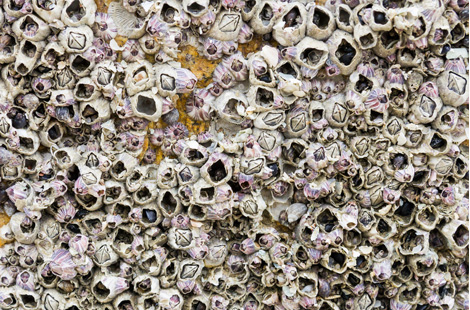Electrochlorination
Prevention of Marine Bio-fouling
Many industries, for example, power stations and oil refineries, are using seawater as a “coolant” to control process heat. Although seawater is an excellent and abundant source of “coolant”, it is unfortunately rich with marine organisms which thrive and grow rapidly under these higher temperature conditions. This marine growth will soon restrict the efficient flow of cooling seawater which will jeopardize the efficiency of the heat-exchangers with disastrous consequences. (See the image below for typical marine bio-fouling e.g. barnacle infestation).
The precautionary action to this is better known as “the prevention of marine bio-fouling” and is vital where seawater is used for either cooling or other industrial processes. Chlorination, in the form of onsite generated HYPO, has been proven to be the most cost-effective and safest method for the prevention of marine bio-fouling and is the worldwide industry standard.
NOTE: HYPO is just a shortened name for sodium hypochlorite, NaOCl, also known as “bleach”. HYPO is a chlorine alternative and a very effective biocide. It controls marine growth by means of oxidation.
Onsite generation of HYPO
HYPO is generated by means of a process plant better known as an on-site electrochlorination system. On-site electrochlorination is an electro-chemical process whereby seawater (or an artificial brine solution) is converted into HYPO by means of electrolysis by passing DC through titanium electrodes (anodes & cathodes). It is essential for the anodes to be coated with Mixed Metal Oxides, also called MMO coating. The electrodes are housed inside an enclosure better known as an ELECTROLYSER or ELECTROLYSER CELL.
The concept is very simple. A small fraction of the seawater which is used as “coolant” is simultaneously by-passed through an electrochlorination system. It is electrolysed into HYPO and dosed back into the seawater circuit. Fortunately, seawater contains salt (sodium chloride) which is the source of the chlorine in HYPO. On-site electrochlorination is the only process where HYPO is generated onsite and on-demand and therefore the safest and most cost-effective source of chlorine when compared to all other chlorine alternatives e.g. gaseous Cl2, commercial strength HYPO, or calcium hypochlorite (“dry chlorine”).
The advantages of onsite generated HYPO
- is the most cost-effective source of chlorine because it is generated from seawater which comes with salt, all free of charge!
- is generated on-site and on-demand.
- is the safest source of chlorine because there is no transport, handling or storage of dangerously high concentrated chlorine based chemicals.
- no decomposition (loss of chlorine) because generated HYPO is always “freshly” used directly after been generated.
- unlimited chlorine supply.
- can be operated and controlled fully automatically. This control can be done either locally or from a remote location.
- maintenance is relatively easy and low cost.
- during oxidation all HYPO decomposes back to the original seawater before it was electrolyzed.
Typical industries where onsite generated HYPO is used
- power stations
- petrochemical plants / oil refineries
- oil & gas installations
- LNG terminals (liquefied natural gas plants)
- offshore platforms & FPSO’s
- ballast water treatment for marine vessels
- desalination plants & RO plants
- potable water plants
- waste water plants
- process water treatment plants, etc.

Typical Marine Bio-Fouling ... barnacle infestation

Contact Us
Tel: +44 (0)1603 260663
email: sales@chlorgenerators.com
Chlor Generators (UK) Ltd
Unit 10 Delta Close
Norwich
NR6 6BQ, United Kingdom
Copyright Chlor Generators Ltd. 2021 / All Rights Reserved
